
India imported $14.72 billion worth of gold in October 2025, according to data from the country’s Ministry of Commerce and Industry. This is three times more than in October last year, 1.5 times more than in September this year, and is set to be a historic record (last year, a slightly higher figure was reported in November, but it was later revised).
“The growth in gold imports in October was phenomenal, despite very high world prices,” said Indian Deputy Minister of Commerce and Industry Rajesh Agrawal, according to The Hindu. “The growth in silver was also phenomenal.” Silver imports increased 6.3 times, to $2.72 billion.
“The continuous rise in gold prices ahead of the festive season could have led to speculative demand, which may not be sustained in the future, possibly leading to some decline in imports in the coming months,” warns Aditi Nayar of Indian rating agency ICRA.
In just 10 months of 2025, India imported $50.74 billion worth of gold, up 17% from the same period last year (October’s results reversed the trend).
India is one of the world’s largest consumers of gold, producing virtually none itself.
Earlier, the Experts Club analytical center presented an analysis of the world’s leading gold-producing countries in its video on YouTube channel — https://youtube.com/shorts/DWbzJ1e2tJc?si=YuRnDiu7jtfUPBR9
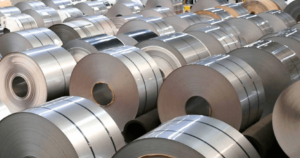
Global demand for steel in 2025 will remain at the previous year’s level — about 1.748 billion tons, after a 1.6% decline in 2024. These figures are given in the short-term forecast of the World Steel Association (Worldsteel) — Short Range Outlook (SRO).
In 2026, according to experts, demand will grow by 1.3% to 1.772 billion tons, driven by recovery in Europe, India, and the rapidly developing countries of Asia, the Middle East, and Africa.
According to Worldsteel’s forecast, in the CIS countries, including Ukraine, demand for steel will decline by 5.2% in 2025, to 56.1 million tons, and by another 1.7% in 2026, to 55.2 million tons.
At the same time, India will retain its status as the world’s fastest-growing steel market, with growth of around 9% annually in 2025-2026. Already next year, steel consumption in India will be almost 75 million tons higher than in 2020.
In developing countries (excluding China), demand for steel will increase by 3.4% in 2025 and by 4.7% in 2026, driven by active economic development in ASEAN countries, as well as in Saudi Arabia and Egypt.
In Africa, steel consumption is growing by an average of 5.5% annually, reaching 41 million tons in 2025 — the highest level in the last decade. Growth is driven by investments in construction and improved macroeconomic indicators.
Andriy Ozeychuk, Chairman of the Board of Directors of the Ukrainian Steel Construction Center and Director of Rauta, commented on the market situation and prospects for the Ukrainian steel sector.
“The Ukrainian steel market in 2025–2026 will be shaped by the recovery of domestic demand in construction and machine building, as well as the growth of exports of metal structures to the EU. We predict that demand for steel in Ukraine may grow by 6-8% in 2026 due to infrastructure and industrial recovery projects,” Ozeychuk said.
According to him, the steel construction sector will be the driver of this growth:
“The use of metal structures will accelerate the restoration of logistics, industrial, and infrastructure facilities.”
Ozeychuk also stressed that the launch of joint programs with European partners in the field of “green” metallurgy, where Ukraine already has its first pilot initiatives for the production of steel with a low carbon footprint, could give the industry an additional boost.
According to the forecast, demand for steel in the EU+UK region will increase by 1.3% in 2025 and by 3.2% in 2026. This reflects the impact of increased investment in infrastructure and defense amid lower inflation and improved household incomes.
In the US, Worldsteel expects steel consumption to increase by 1.8% in both 2025 and 2026. The main drivers of growth will be government spending on infrastructure, a revival in housing construction, and private investment.
In China, steel demand will continue to decline, by approximately 2% in 2025, due to the prolonged downturn in the real estate market. In 2026, the rate of decline will slow to 1% as the construction sector is expected to bottom out.
Worldsteel warns that a more challenging global trade environment and financial pressure on local authorities could further limit infrastructure investment and reduce demand.
According to Alfonso Hidalgo de Calcerrada, chief economist of the Spanish Steel Manufacturers Association (UNESID) and chairman of the Worldsteel Economic Committee, the organization is “cautiously optimistic” about the market outlook:
“Despite trade disputes and uncertainty, we believe that global steel demand will bottom out in 2025 and show moderate growth in 2026,” the expert said.
He added that this will be facilitated by the resilience of the global economy, growth in infrastructure investment, and easing financial conditions. At the same time, the sector continues to be pressured by high costs, trade barriers, and geopolitical risks.
Worldsteel’s forecast emphasizes that the decline in demand in China is offset by strong growth in India and developing countries, where a new center of global steel production is emerging.
In addition, the protective measures introduced by the European Union — reducing duty-free import quotas and increasing customs duties to 50% — may change the balance between EU producers and exporters from Asia and Eastern Europe.
For more information on the largest steel producers and global industry trends, see the Experts Club video analysis review available on YouTube: Experts Club — Leaders of the global steel industry 1990–2024
CHINA, EU, EXPERTS CLUB, global economy, INDIA, OZEYCHUK, RAUTA, USA, World Steel, WORLDSTEEL
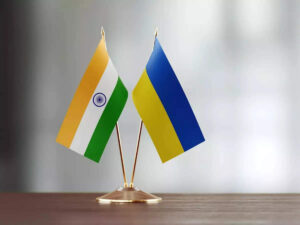
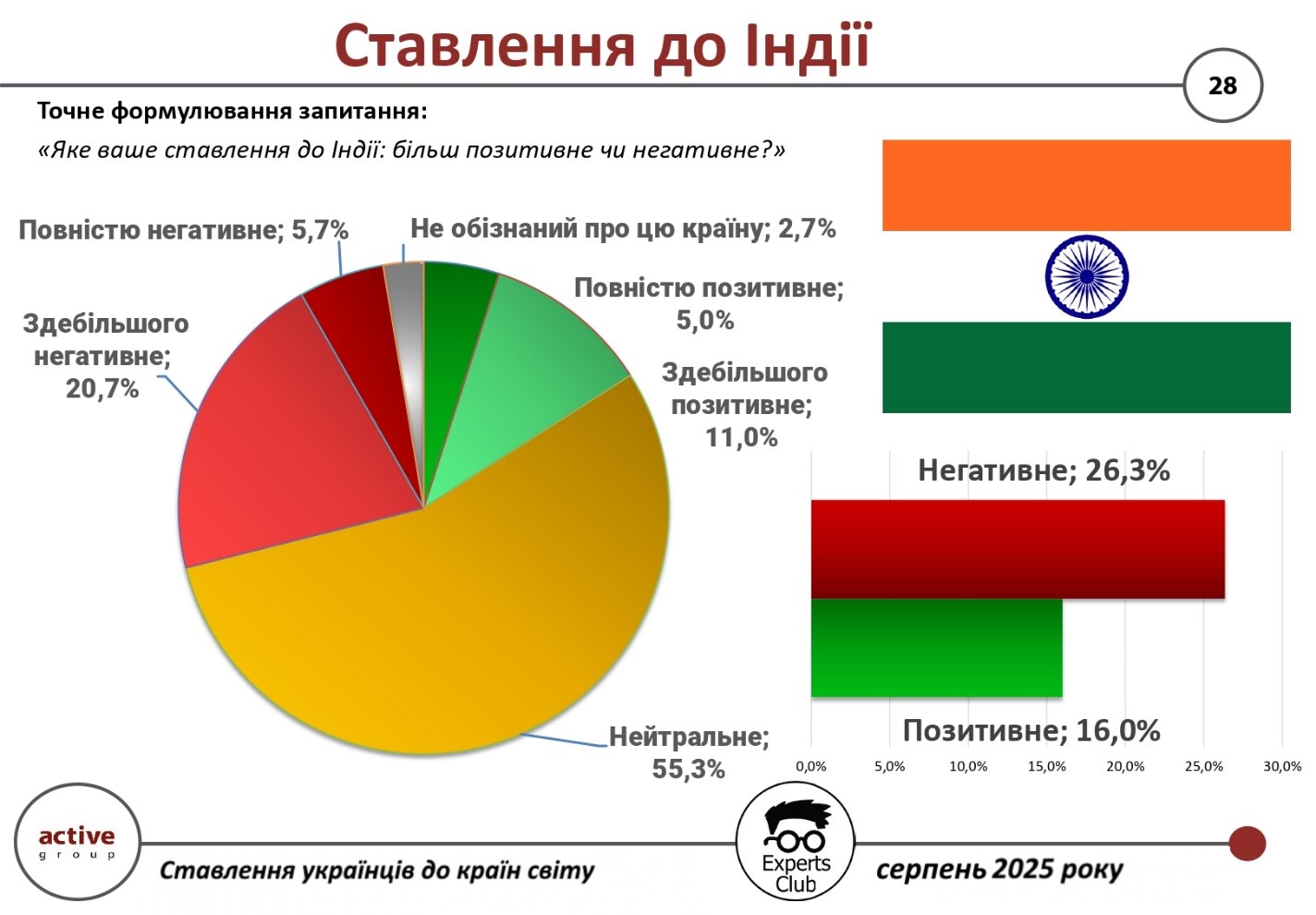
In August 2025, Ukrainians’ attitudes toward India were mostly neutral and partly negative. This is evidenced by the results of an all-Ukrainian sociological survey conducted by Active Group in cooperation with the Experts Club information and analytical center.
According to the results, only 16.0% of Ukrainian citizens demonstrated a positive attitude toward India (11.0% – mostly positive, 5.0% – completely positive). This country is negatively rated by 26.3% of respondents (20 . 7% – mostly negative, 5.7% – completely negative). At the same time, the vast majority – 55.3% – expressed a neutral attitude, and 2.7% said they did not have enough information.
“India remains one of the most important global players, but the country is not clearly defined in the public opinion of Ukrainians. This is influenced by both New Delhi’s political decisions in the international arena and limited cultural communication with Ukraine,” commented Maksym Urakin, founder of Experts Club.
He also drew attention to the economic dimension of bilateral relations:
“In the first half of 2025, the trade turnover between Ukraine and India amounted to more than $1.1 billion. At the same time, Ukrainian exports amounted to only $401.9 million, while imports from India exceeded $702 million. The negative balance of more than $300 million demonstrates a structural imbalance in trade,” Urakin emphasized.
In his turn, Active Group co-founder Oleksandr Poznyi added that these results indicate a cautious attitude of Ukrainians:
“Despite India’s economic weight and global status, the country remains remote and little understood for many Ukrainians. This explains the high level of neutral assessments and the low expression of positive emotions in society,” he emphasized.
The survey is part of a broader research program that analyzes international sympathies and antipathies of Ukrainians in the current geopolitical context.
The full video can be viewed here:
https://www.youtube.com/watch?v=YgC9TPnMoMI&t
You can subscribe to the Experts Club YouTube channel here:
https://www.youtube.com/@ExpertsClub
ACTIVE GROUP, DIPLOMACY, EXPERTS CLUB, INDIA, Poznyi, SOCIOLOGY, TRADE, URAKIN
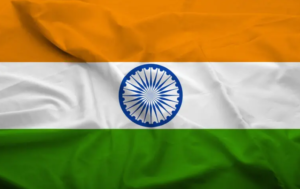
India has again opposed the expansion of the Shanghai Cooperation Organization (SCO), rejecting Azerbaijan’s application for full membership. This was reported by AnewZ, citing diplomatic sources cited by the media. X (formerly Twitter)+14EADaily+14Report.az+14
On the other hand, Pakistan has so far refrained from supporting Armenia’s accession to the SCO. Pakistan’s geopolitical ties with Azerbaijan, as well as its historical positions in the conflicts of the region can become an obstacle in Yerevan’s way.
The Shanghai Cooperation Organization is an intergovernmental regional bloc founded in 2001 in Shanghai. Now it has 10 full members: China, Russia, Kazakhstan, Kyrgyzstan, Tajikistan, Uzbekistan, India, Pakistan, Iran and Belarus.
In 2025, Armenia and Azerbaijan applied for full SCO membership status (previously they were observers or dialog partners). Their ratification requires the approval of all current members.

Ukraine is increasing exports of sunflower oil to India. In July 2025, it supplied 78,000 tons to this country, which is 57% more than in June, according to the analytical agency UkrAgroConsult.
The agency cited Indian sources, according to which Ukrainian oil accounted for 39% of total imports of this product to India in July, which amounted to 200,000 tons. Thus, for the first time since the start of the war,
Ukraine has overtaken Russia, whose exports to India in this segment amounted to 49,000 tons, or 25% of the total volume imported into the country.
“In recent seasons, Russia has dominated the Indian sunflower oil market, while Ukraine’s share has fluctuated between 13% and 34%. However, in the second half of the 2024/25 season, Russian producers reduced production volumes due to low profitability, which led to a decrease in supply on foreign markets. An additional factor was the non-zero export duty on Russian oil,” experts explained.
According to analysts, Ukraine exported 767,000 tons of sunflower oil to India between September 2024 and July 2025, which is 55% more than in the same period of the previous season.
“This figure is a record since 2022, confirming India’s position as a key importer of Ukrainian oil. The growth in exports reflects the stable recovery of Ukraine’s position in the global market,” UkrAgroConsult concluded.
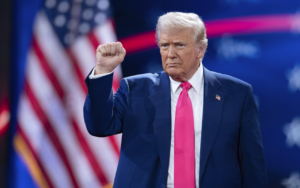
US President Donald Trump has decided to impose additional tariffs of 25% on India due to its purchase of Russian oil, according to a presidential decree published by the White House.
“Thus, goods from India imported into the US will be subject to ad valorem duties of 25%,” the document says.
“I have determined that it is necessary and appropriate to impose ad valorem duties on imports from India that directly or indirectly purchase oil from the Russian Federation,” Trump explained in the decree.
Ad valorem duties are levied as a fixed percentage of the price of the goods, rather than per unit of cargo.
At the same time, the order specifies that it applies not only to oil of Russian origin, but also to petroleum products.
“The term ‘oil of the Russian Federation’ means crude oil and petroleum products extracted, refined, and exported from the Russian Federation, regardless of the nationality of the company involved in the production or sale of oil or petroleum products,” the document explains.
The term “indirect import” is also clarified, which, according to the US, means the purchase of Russian oil through intermediaries or third countries, whereby the origin of the oil can be traced back to Russia if the head of the Ministry of Trade, who consulted with the Secretary of State and the head of the Ministry of Finance, comes to such conclusions.
Last week, Trump announced that he was imposing 25% tariffs on Indian goods, as well as “penalties” for India’s purchase of Russian oil and weapons. Trump later expressed hope that India would stop buying Russian oil.
Trump then threatened to seriously increase tariffs on Indian exports, arguing that India’s purchases of Russian oil contribute to the continuation of Russia’s military aggression against Ukraine.
In turn, the Indian Foreign Ministry said that the US and EU’s dissatisfaction with Delhi’s purchase of Russian oil was unfounded. Trump’s threats were also condemned by the ruling party and the opposition in India.